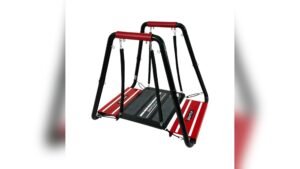If you want to get the most out of your resistance band workouts, mastering the use of a door anchor is a game-changer. You might already have resistance bands, but without the right setup, you’re missing out on a wide range of effective exercises.
Using a resistance band door anchor lets you turn any sturdy door into a versatile workout station. Imagine being able to target different muscle groups easily, right at home or on the go. In this guide, you’ll learn simple, step-by-step instructions on how to safely and securely use your door anchor.
By the end, you’ll feel confident to expand your routine and maximize your results. Ready to unlock new workout possibilities? Let’s dive in!

Credit: fitcord.com
Table of Contents
ToggleChoosing The Right Door Anchor
Choosing the right door anchor is key for safe and effective resistance band workouts. It helps secure the bands firmly, allowing smooth and controlled exercises. A good door anchor fits your door type and withstands your workout intensity. This section guides you through important points to pick the best one.
Types Of Door Anchors
Door anchors come in several styles. The most common are foam anchors that sit on the door frame. They prevent damage and provide a soft barrier. Another type uses straps with hooks to latch onto the door handle. Some anchors have a loop design to thread the band through easily. Choose a style that matches your workout needs and door setup.
Material And Durability
Strong materials ensure safety during workouts. Look for anchors made from thick nylon straps and high-density foam. The foam should be firm but cushiony to protect the door. Durable stitching keeps the anchor from tearing under tension. Avoid cheap plastic parts that can break quickly. A well-made anchor lasts longer and supports heavy resistance bands.
Compatibility With Doors
Not all anchors work with every door type. Check if your door opens inward or outward. Most anchors fit standard interior doors. Wider or metal doors may need special anchors. Measure the door thickness before buying. Also, make sure the anchor does not block the door latch or lock. Proper fit keeps the anchor secure and prevents accidents.

Credit: fitcord.com
Setting Up Your Door Anchor
Setting up your resistance band door anchor correctly ensures a safe and effective workout. This process involves placing the anchor in the right spot, making sure it is secure, and confirming the door can handle the tension. Proper setup prevents accidents and improves your exercise experience.
Positioning On The Door
Place the door anchor at the top, side, or bottom of the door. Choose a spot that fits your exercise type. The anchor should be on the hinge side or the side that closes tightly. Avoid areas where the door might open during use.
Securing The Anchor Safely
Close the door firmly after placing the anchor. Pull the anchor strap through the door frame and ensure the thick end is on the other side. Test by pulling gently on the anchor to check if it stays in place. Never use a door that is loose or does not close well.
Checking Door Stability
Make sure the door is strong and stable. Use a solid door with a sturdy frame. Avoid glass or lightweight doors that may break or bend. Confirm the door latch locks or holds tightly to prevent it from opening during your workout.
Attaching Resistance Bands
Attaching resistance bands to a door anchor is simple and safe. Proper attachment ensures effective workouts and protects your bands. Follow clear steps to secure your bands correctly. This helps maintain tension and prevents slipping during exercises.
Understanding how to connect your bands is key. Use the right tools and techniques for a stable setup. This section explains how to attach bands using carabiners and loops, adjust length and tension, and avoid common mistakes.
Using Carabiners And Loops
Carabiners provide a quick and secure way to attach bands. Clip the band loop to the carabiner on the door anchor. Make sure the carabiner closes fully to avoid accidents. Loops on bands fit easily over door anchors without extra clips. Choose the method that feels safest and strongest for your workout.
Adjusting Band Length And Tension
Adjusting length controls workout difficulty. Shorten the band by pulling it through the carabiner or anchor. Longer bands reduce resistance, making exercises easier. Check tension before starting. The band should feel tight but not overstretched. Correct tension improves muscle engagement and reduces injury risk.
Common Attachment Mistakes
Not securing the door anchor firmly is a common error. Ensure the anchor is tightly closed on the door frame. Avoid placing bands too close to the door edge to prevent slipping. Do not twist bands during attachment as this weakens them. Inspect bands and anchors for wear before use. Proper care extends band life and keeps workouts safe.
Effective Exercises With Door Anchor
Using a resistance band door anchor expands your workout options. It creates a stable point for resistance bands. This setup allows for many effective exercises. It targets various muscle groups. You can train upper body, lower body, and core. Each exercise helps build strength and flexibility.
Upper Body Workouts
Attach the door anchor at the top of the door. Try chest presses by pushing the bands forward. Perform rows by pulling bands toward your chest. Do shoulder presses by lifting bands overhead. These moves strengthen chest, back, and shoulders. Keep your movements slow and controlled. Use a medium resistance band for best results.
Lower Body Movements
Place the door anchor at the bottom of the door. Step back to create tension on the bands. Try leg lifts by pulling the band with your ankle. Do squats by holding bands at shoulder height. Perform glute kickbacks by extending your leg backward. These exercises improve leg and glute strength. Use a heavier band for more challenge.
Core Strengthening Routines
Fix the anchor at the middle of the door. Stand sideways and pull bands across your body. Try woodchoppers by twisting while pulling the band down. Do seated rotations with bands around your hands. Perform standing twists to engage your obliques. These moves build strong, stable core muscles. Keep your core tight during each exercise.
Safety Tips And Precautions
Using a resistance band door anchor is a smart way to add variety to your workouts. Safety must be your top priority. Taking simple precautions helps avoid injuries and protects your door. Follow these essential safety tips to exercise confidently and safely.
Preventing Door Damage
Place the door anchor on the side that closes toward you. Ensure the door closes fully and locks if possible. Avoid placing the anchor on weak or glass doors. Use a towel or cloth between the anchor and the door to reduce pressure. Check that the door frame is sturdy enough to handle resistance.
Avoiding Band Slippage
Secure the band tightly around the anchor before starting. Pull the band slowly to test its hold. Avoid sudden or jerky movements during exercises. Keep the band away from sharp edges or rough surfaces. Wear shoes with good grip to maintain balance while exercising.
Inspecting Equipment Regularly
Check the resistance band for tears or cracks before each use. Examine the door anchor for wear and loose parts. Replace any damaged bands or anchors immediately. Clean your equipment to prevent dirt buildup that can weaken bands. Regular inspection extends equipment life and keeps you safe.
Maintaining Your Equipment
Maintaining your resistance band door anchor ensures safety and extends its lifespan. Proper care helps you avoid accidents and keeps your workouts smooth. Regular attention to your equipment saves money and effort in the long run.
Cleaning Resistance Bands
Wipe resistance bands with a damp cloth after use. Avoid harsh chemicals that can damage the material. Use mild soap and water for deeper cleaning. Let the bands air dry completely before storing. Clean bands stay flexible and last longer.
Storing Door Anchors Properly
Store door anchors in a cool, dry place away from sunlight. Avoid folding or crushing them to prevent damage. Keep them separate from heavy or sharp objects. Proper storage keeps the anchor strong and ready to use.
Replacing Worn Components
Check bands and anchors regularly for signs of wear or tears. Replace any parts that show cracks or weakness immediately. Using worn components can cause injuries or break during exercise. Fresh equipment ensures safe and effective workouts.
Troubleshooting Common Issues
Troubleshooting common problems with resistance band door anchors helps keep workouts safe and effective. Small issues can stop your exercise routine. Fix problems quickly to maintain smooth sessions. Here are solutions to frequent concerns users face.
Anchor Not Staying Secure
Check the door thickness before use. Thin doors may not hold the anchor firmly. Close the door completely to avoid slipping. Place the anchor on the hinge side for better grip. Use a towel or cloth between the door and anchor for extra friction. Avoid heavy pulling that may loosen the anchor. Regularly inspect the anchor for wear or damage.
Bands Losing Elasticity
Keep bands away from direct sunlight and heat. Store bands in a cool, dry place to prevent damage. Clean bands with mild soap and water after use. Avoid stretching bands beyond recommended limits. Replace bands if you see cracks or thinning. Use bands according to their resistance level to extend life. Proper care keeps bands flexible and safe.
Dealing With Door Scratches
Use a protective cover or cloth on the door frame. Place the anchor on smooth, non-painted door edges. Avoid sharp or rough surfaces that may scratch doors. Check anchor padding regularly and replace if worn. Use door anchor straps with soft, wide loops to reduce pressure. Protecting your door keeps your home looking good and equipment safe.

Credit: www.gosupps.com
Advanced Tips For Better Workouts
Advanced tips can help you get more from your resistance band door anchor workouts. Small changes make exercises more effective and challenging. These tips improve strength, endurance, and muscle tone.
Combining Bands For Resistance
Use two or more bands together for added resistance. Attach different bands to the door anchor at once. This increases the tension and makes muscles work harder. Try mixing light and heavy bands for varied difficulty.
Changing band combinations keeps workouts fresh. It helps avoid plateaus and improves muscle growth. Adjust band thickness or length to match your fitness level.
Using Multiple Anchors
Place door anchors at different heights on the door. This allows targeting various muscle groups. For example, a high anchor works shoulders and back. A low anchor focuses on legs and glutes.
Multiple anchors enable more exercise variety. You can perform pulling, pushing, and rotational movements. This creates a full-body workout using just one door.
Incorporating Door Anchor In Circuits
Include door anchor exercises in your circuit training routines. Combine resistance band moves with bodyweight exercises. This boosts cardio and strength at the same time.
Set a timer for each exercise and switch quickly. Use the door anchor for rows, presses, and leg work. Circuits increase calorie burn and improve overall fitness.
Frequently Asked Questions
How Do You Use A Resistance Band Door Anchor?
Place the door anchor over the closed door’s top or side edge. Close the door securely. Thread the resistance band through the anchor loop. Step back to create tension. Perform exercises by pulling the band safely.
Are Door Anchor Resistance Bands Safe?
Door anchor resistance bands are safe if securely attached to a sturdy door and used with proper technique. Always check for wear and avoid damaged anchors. Ensure the door closes firmly to prevent slipping and injury. Use padding to protect door surfaces from scratches and dents.
How To Install Resistance Band Anchors?
Place the anchor strap over the door’s top or side edge. Close the door firmly. Insert the resistance band through the anchor loop. Ensure the door is fully closed before exercising for safety.
How To Set Up A Door Anchor?
Place the door anchor over the top, side, or bottom of a sturdy door. Close and lock the door securely. Insert the resistance band through the anchor loop. Pull the band to create tension before starting exercises. Always check the anchor and door for stability before use.
Conclusion
Using a resistance band door anchor adds variety to your workouts. It allows safe, stable exercises at home or on the go. Always check the anchor for damage before use. Step back to create tension for effective training. Simple setup leads to better muscle engagement.
Keep your movements slow and controlled for best results. This tool helps target different muscle groups easily. Practice regularly to improve strength and flexibility. A resistance band door anchor is a smart fitness aid.







